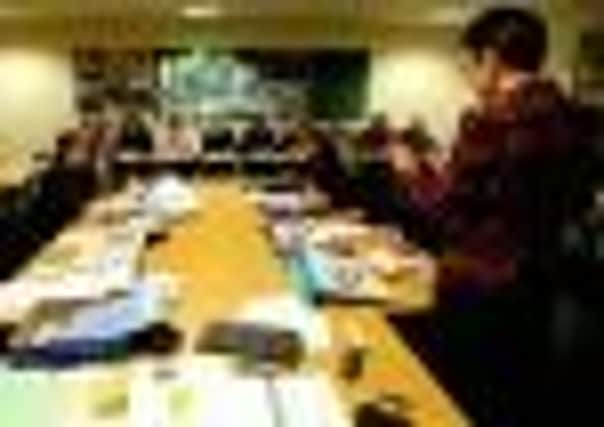Secondary School league tables in full: Barnsley, Hull and Bradford among UK’s worst


__________________
Hear education correspondent John Roberts debate the issues
CLICK HERE TO PLAY NOW,Play now or, if you prefer, DOWNLOAD FOR LATER (Right-click and choose Save Target As...)
LEAGUE TABLES IN FULL
Click the links to download tables for each local authority, from the Department for Education
• BARNSLEY
• BRADFORD
• HULL
• KIRKLEES
• LEEDS
• YORK
__________________
Advertisement
Hide AdAdvertisement
Hide AdThe three education authorities were all ranked in the bottom ten of 150 council areas across England despite all recording improved results last year, new figures from the Department for Education (DfE) reveal.
In each of these areas and in Sheffield schools less than half of the pupils sitting GCSEs last summer managed to achieve five good passes including English and maths.
There are 39 secondary schools in Yorkshire among the worst 200 in the country according to the new tables. Twenty five Yorkshire schools had less than 35 per cent of pupils achieving five A* to C grades including English and maths - the minimum target set by ministers.
The City of Leeds School had the lowest GCSE pass rate in the region and the ninth worst nationally with just over one in five pupils achieving those grades.
Advertisement
Hide AdAdvertisement
Hide AdNationally there are 107 secondaries in England which did not reach tough government targets which ministers say are intended to raise standards.
Schools that fail to meet the strict thresholds have been warned they are at risk of closure or being taken over if they do not improve.
The school performance tables also reveal for the first time how pupils from deprived backgrounds performed in exams. The statistics reveal that just a third of students from poorer homes achieve five A* to C GCSE grades including English and maths compared with a national average of 58 per cent.
The figures also show major discrepancies in how well poorer students perform at different schools.
Advertisement
Hide AdAdvertisement
Hide AdThere are 339 schools nationally with more than 10 disadvantaged pupils, where fewer than 20 per cent achieved five A* toC grade GCSEs including English and maths. In contrast 21 schools, with more than 10 disadvantaged pupils, saw more than 80 per cent of those pupils reaching that standard.
Schools Minister Nick Gibb said: “We should have high expectations for all children regardless of their circumstances. Today’s figures reveal a shocking waste of talent in many schools across the country. All too often, pupils from disadvantaged backgrounds aren’t given the same opportunities as their peers.
“But there are great examples of schools achieving the best for their disadvantaged pupils. If they can get it right, then so can all schools.”
The league tables also show how schools have performed in the Government’s controversial English Baccalaureate - a performance measure which was used for the first time in last year’s league tables.
Advertisement
Hide AdAdvertisement
Hide AdThe E-Bacc is awarded to pupils who achieve at least six A* to C GCSE grades comprising English, maths, two sciences, a humanity - either history or geography - and a modern language.
Tables show that just one-in-25 disadvantaged pupils managed to secure the grades needed to achieve this compared to the national average of nearly one-in-six.
The Grammar School at Leeds had the highest E-Bacc score in the region with 86 per cent of pupils achieving the necessary grades.
Mr Gibb added: “Thanks to the introduction of the E-Bacc, we are opening up opportunities for all pupils to study the core academic subjects that employers and universities demand. And with the pupil premium we are specifically targeting funding at disadvantaged pupils, so that schools have the resources they need to make a difference.”
Advertisement
Hide AdAdvertisement
Hide AdFor the first time, the tables also highlight how pupils have progressed since they left primary school.
The figures show that in a small number of cases - 6.5 per cent of pupils - secondary schools have helped children who were below the expected standard at the end of primary school to achieve the expected standard at GCSE.
However the reverse is also true. There were 8,600 pupils, 4.9 per cent, who were excelling at the end of primary school, who then failed to gain to five A* to C grades including English and maths according to the DfE.
Mr Gibb added: “Children only have one chance at education. These tables show which schools are letting children down. We will not hesitate to tackle underperformance in any school, including academies. Heads should be striving to make improvements year on year, and we will not let schools coast with mediocre performance.
Advertisement
Hide AdAdvertisement
Hide Ad“We are driving up standards right across the board. We are bringing the best graduates into teaching, developing a world-class curriculum, and restoring order to our classrooms. We have introduced a tough new inspection regime targeted at the weakest performing schools and Ministers now have clear new powers to intervene when schools are failing.”